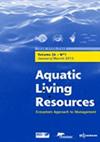法国的渔业和水产养殖产品消费:当Covid-19危机没有导致更可持续的采购时
IF 1.9
4区 农林科学
Q3 FISHERIES
引用次数: 0
摘要
就食品消费而言,可持续性方面往往与购买力和实际购买量相冲突。法国种植、养殖、进口和消费大量的渔业和水产养殖产品。这一流行病通过限制贸易和捕鱼条件,影响了国内外农产品供应。疫情期间关闭了许多提供FAPs的销售点。这种大背景可能会质疑消费者在环境、经济和社会事务中的作用。本文的目的是评估新冠肺炎危机是否为法国消费者提供了一个机会,通过支持国内生产商、短渠道或环保产品,使他们的国内消费与环境问题保持一致。2017年至2021年法国大都市普通家庭家庭购买的定量数据与t检验方法一起使用。尽管有进口限制和现有的盈余,新鲜FAPs的消费似乎并没有真正适应国内鱼类生产。虽然2020年国内新鲜贝类的消费没有明显变化,但三文鱼和鳕鱼仍然受到法国消费者的广泛青睐,尽管它们在法国的产量几乎不存在。相反,国内生产的鱼类仍然很少在国内消费。原本供应给其他市场的新鲜鲑鱼供应充足,巩固了该物种在法国家庭消费市场上的主导地位。由超级市场和大卖场发起,由消费者跟进,购买预包装鲜鱼的趋势因大流行而大大扩大,并似乎持续一段时间。本文章由计算机程序翻译,如有差异,请以英文原文为准。
Fisheries and aquaculture products consumption in France: when the Covid-19 crisis did not lead to more sustainable purchases
In terms of food consumption, sustainability dimensions are often conflicting with purchasing power and practical purchases. France lands, farms, imports, and consumes large quantities of fisheries and aquaculture products (FAPs). The pandemic affected both domestic and foreign FAP supply through restrictions on trade and fishing conditions. Numerous sale points offering FAPs were closed during the pandemic. This general context has likely questioned the role of consumers on environmental, economic, and social matters. The aim of the paper is to assess whether the Covid-19 crisis has been an opportunity for French consumers to align their consumption at-home with the environmental issues by favouring domestic producers, short channels, or eco-friendly products. Quantitative data on at-home ordinary household purchases in metropolitan France from 2017 to 2021 was used along with t-test methods. It seems that fresh FAPs consumption did not truly adapt to the domestic fish production in defiance of import restrictions and available surpluses. While fresh shellfish at-home consumption did not change significantly in 2020, salmon and cod are still widely favoured by French consumers at-home, although their French production is virtually non-existent. On the contrary, domestically produced fish species remains poorly consumed at-home. The abundant supply of fresh salmon initially intended for other markets has permitted to consolidate the dominant position of this species on the French at-home consumption market. Initiated by supermarkets and hypermarkets and followed up by consumers, the trend of purchasing pre-packaged fresh fish has been substantially amplified by the pandemic and seems to persist over time.
求助全文
通过发布文献求助,成功后即可免费获取论文全文。
去求助
来源期刊

Aquatic Living Resources
农林科学-海洋与淡水生物学
CiteScore
2.30
自引率
0.00%
发文量
10
审稿时长
>24 weeks
期刊介绍:
Aquatic Living Resources publishes original research papers, review articles and propective notes dealing with all exploited (i.e. fished or farmed) living resources in marine, brackish and freshwater environments.
Priority is given to ecosystem-based approaches to the study of fishery and aquaculture social-ecological systems, including biological, ecological, economic and social dimensions.
Research on the development of interdisciplinary methods and tools which can usefully support the design, implementation and evaluation of alternative management strategies for fisheries and/or aquaculture systems at different scales is particularly welcome by the journal. This includes the exploration of scenarios and strategies for the conservation of aquatic biodiversity and research relating to the development of integrated assessment approaches aimed at ensuring sustainable and high quality uses of aquatic living resources.
 求助内容:
求助内容: 应助结果提醒方式:
应助结果提醒方式:


